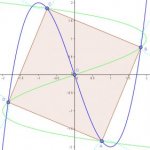I have been playing around with this problem but not making much progress:
For which values of k is it possible to draw a square using four points that lie on the curve with equation y = x3 − kx?
Any hints/thoughts to get started would be gratefully received!
What i have tried to so far:
- I have thought about what properties might be true for four points to form a square:
For example, if ( a, b) is the coordinates of the first point say A, then B could be (a+c, b+d) and C (a+c-d, b+d+c) & D(a-d, b+c)
So a=3, b=4 and c=2, d=5 ( for example). The following points form a square:
A= (3,4) B= (5,9) C= (0,11) and D=(-2, 6)
Now do these lie on y= y = x3 − kx ?
It doesn't appear so as they don't solve for a unique value of k.
If i keep it general, the algebra gets unbearable. Is there some kind of symmetry argument i am missing?
For which values of k is it possible to draw a square using four points that lie on the curve with equation y = x3 − kx?
Any hints/thoughts to get started would be gratefully received!
What i have tried to so far:
- I have thought about what properties might be true for four points to form a square:
For example, if ( a, b) is the coordinates of the first point say A, then B could be (a+c, b+d) and C (a+c-d, b+d+c) & D(a-d, b+c)
So a=3, b=4 and c=2, d=5 ( for example). The following points form a square:
A= (3,4) B= (5,9) C= (0,11) and D=(-2, 6)
Now do these lie on y= y = x3 − kx ?
It doesn't appear so as they don't solve for a unique value of k.
If i keep it general, the algebra gets unbearable. Is there some kind of symmetry argument i am missing?








